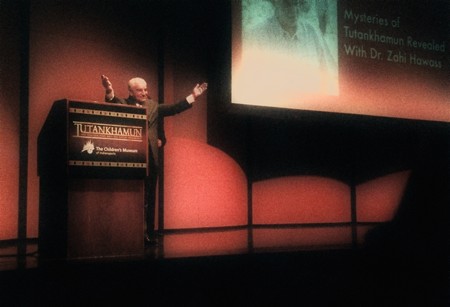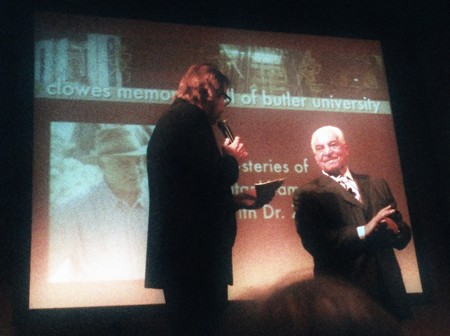 More than two thousand Egyptophiliacs lined up outside Clowes Memorial Hall for what Director of Operations Karen Steele informed me was a sold-out house. Even as funding for the arts is being cut, an event like this sells out in days.”
More than two thousand Egyptophiliacs lined up outside Clowes Memorial Hall for what Director of Operations Karen Steele informed me was a sold-out house. Even as funding for the arts is being cut, an event like this sells out in days.”
It would not be too much of an exaggeration to say Zahi Hawass’s lecture, The Mysteries of King Tut Revealed, had the feel of a rock concert. We were there to see a star. What secrets would he reveal tonight? What announcements would he make?
The evening began with a brief introduction by Mark Lach, Senior Vice President of Arts and Exhibitions International, the company that has produced such award winning exhibitions as Diana A Celebration and Real Pirates: The Untold Story of the Whydah from Slave Ship to Pirate Ship, and who have been touring the Tut exhibition worldwide for the last five years. Mr. Lach was followed by Jeffrey Patchen, President and CEO of the Indianapolis Childrens Museum.
Mr. Patchen first met Dr. Zahi Hawass while designing a travelling exhibit with National Geographic entitled National Geographic Maps: Tools for Adventure, which featured Dr. Hawass as one of the explorers. When they flew to Cairo for the filming, Dr. Hawass invited Mr. Patchen to attend a planning and review meeting for the Suzanne Mubarak Childrens Museum. During the course of the evening, Dr. Hawass convinced Her Excellency Mrs. Mubarak that the Indianapolis Childrens Museum should design all of the exhibits for the Suzanne Mubarak Childrens Museum. In exchange for all their work, Dr. Hawass promised that the Tut exhibition would come to Indianapolis, and the rest, as they say, is history.
Goings-On at Giza
After a short biographical video, Dr. Hawass began the lecture with an update of various archaeological projects currently underway on the Giza Plateau. Of course, the most widely followed story is that of the secret doors found in the Great . Ever since the discovery in 2002 of a second door in the southern shaft leading from the Queens Chamber, and a third door in the northern shaft, exploration of this mystery has been high on the Supreme Council of Antiquities list of priorities.
 It has been widely published that a team from Leeds University was selected to conduct the survey, and that they spent the month of July, 2009, testing their robotic explorer in the desert sands of the plateau. What is not so widely known is that the team from Leeds began the actual investigation of the secret doors last week, and according to Dr. Hawass, on July 31 the Leeds team had a major breakthrough.
It has been widely published that a team from Leeds University was selected to conduct the survey, and that they spent the month of July, 2009, testing their robotic explorer in the desert sands of the plateau. What is not so widely known is that the team from Leeds began the actual investigation of the secret doors last week, and according to Dr. Hawass, on July 31 the Leeds team had a major breakthrough.
In this coming December, Dr. Hawass avowed, Im promising all of you that the secrets of the will be revealed for the first time. But if you can’t wait that long, just check out Heritage Keys exclusive interview with Zahi Hawass.
Dr. Hawass also offered an update with regard to the Osiris Shafta water-filled tunnel discovered in 1945 under the causeway between Khafres Valley and Mortuary Temples. In 1999 Dr. Hawass began the arduous task of draining and excavating the shaft. He discovered three vertical chambers, the lowest of which is more than 100 feet down.
This chamber contains a large basalt sarcophagus counter-sunk into the center of the room and surrounded by a channel which may have originally been filled with ground water, creating an island. Dr. Hawass believes this may have been a symbolic tomb of Osiris. But most curious is a small tunnel that tapers off from the northwest corner until it disappears into the mud, trailing enticingly toward Khafres Mortuary Temple and his beyond.
Through a combination of people, probes, and robots, Dr. Hawass was able to determine that at just past 21 feet a second tunnel branches off from the main circuit. At last report he had only been able to reach an additional 34 feet into the secondary tunnel, and just shy of 70 feet into the primary tunnel.
Tonight he disclosed that in July he brought a Chinese researcher to the site who was able to insert a camera through a tube 150 feet into the primary tunnel, still without reaching the end. He states in his interview with Heritage Key that a snake robot will be required to explore further.
A New Tomb to be Revealed
 Dr. Hawass also spoke extensively on the exciting work taking place in the Valley of the Kings. For centuries, archaeology has been the province of nearly every nation except Egypt. In 2007, Zahi Hawass set out to change this with the first all-Egyptian team to work the Valley of the Kings. It seems that he is prepared to make history yet again, as his team hopes to reveal a new tomb in October of 2009. He did not give details, but provided plenty of fuel for speculation. Three notable women come to the forefront.
Dr. Hawass also spoke extensively on the exciting work taking place in the Valley of the Kings. For centuries, archaeology has been the province of nearly every nation except Egypt. In 2007, Zahi Hawass set out to change this with the first all-Egyptian team to work the Valley of the Kings. It seems that he is prepared to make history yet again, as his team hopes to reveal a new tomb in October of 2009. He did not give details, but provided plenty of fuel for speculation. Three notable women come to the forefront.
One possibility is a mysterious and unfamiliar queen known only by the partial name, Weret. An inscription was found in the area south of Tutankhamuns tomb bearing her name and the title Gods Wife. In the Eighteenth Dynasty, the Gods Wife of Amun was an important religious and political position reserved for royal women. The team also discovered a ceramic shard with a stunning depiction of this queen making offerings to the gods. The discovery of the tomb of this queen and consort of the god Amun would certainly be worthy of a press conference.
Another candidate is Queen Tiye, the mother of Akhenaten. Tiye was the wife of Amenhotep III, and was possibly the sister of Ay, both of whom are entombed in the Western Valley. Dr. Hawass has made no secret of his search for Tiye in this area, and he may be close to announcing success.
But the real headline would be the discovery of the tomb of Nefertiti. The area south of Tutankhamens tomb has proven to be a lucrative dig, with the discovery of stone storage chambers and various artifacts from the workmens huts originally discovered by Howard Carter.
But most important, to the northeast of Seti Is tomb, under a modern rest house, Dr. Hawass team has discovered evidence of what he believes to be the tomb of Nefertiti. As there are other Amarna Period tombs in the vicinity, Dr. Hawass surmises that finding Nefertitis tomb in that location is highly probable.
However, during his presentation Dr. Hawass also announced that he hopes to reveal the tomb of Nefertiti in the winter of 2009/2010. One possibility is that the announcement in October may simply be the location of the new tomb, with the identification coming in the winter. One thing we do know about the eminent Dr. Hawass is that he knows how to generate excitement and expectation, and his revelations tend to be preceded by a generous amount of foreplay
Doctor, the King is here to See You
Dr. Hawass spent considerable time reviewing the importance of the CT scans and genetic tests being conducted on King Tut and his family. Although much of the territory covered was old news, he did make some tantalizing announcements that put old news into a new perspective.
The first announcement involves genetic testing on one of the fetuses that were found in Tutankhamuns tomb in 1922. Although the younger of the two was too deteriorated for genetic testing, the second was most likely stillborn at nine months and was in sufficient shape to provide a sample.
The first set of tests indicated that the fetus was very likely the daughter of King Tut. Dr. Hawass announced that a second lab has now confirmed those results, and that a paper is to be published next week for purposes of peer review.
Confirmation of Tuts paternity is important because, if Tut is the father, then additional testing will lead to the mother, Tuts wife Ankhesenamun, which will then lead to her mother, Nefertiti. Dr. Hawass mentions in his interview with Heritage Key that this will in turn lead to the identification of Queen Tiye and numerous other Eighteenth Dynasty royals. He also informed Heritage Key that he hopes to break more news about this royal line in a month and a half.
Dr. Hawass also spoke about the CT scans of Tutankhamens mummy. He pointed out that there were about 130 walking sticks discovered in Tuts tomb, along with a depiction of the young king walking with a cane. Dr. Hawass announced with conviction that thanks to the CT scans, the whole world will know in one month why Tut needed a walking stick!
Not exciting enough for you? Then try this. It has long been thought that the boy king may have been murdered due to a hole in the back of his head. Dr. Hawass says this has been misinterpreted, and is actually a post-mortem wound resulting from the mummification process. After more than 1,700 CT scan shots, Dr. Hawass states emphatically that he knows the cause of death, and at a press conference in one month he will reveal the exact reason why King Tut died.
Digging up the Future
While it was certainly exciting to experience Dr. Zahi Hawass enthusiasm first hand, his presentation was mostly a review of the past with announcements of things to come. Thats not too surprising, as this was an engagement with a general audience, not a press conference. But he did make several specific promises, and announcing the future of the past is no small business. Most of the discoveries that we do now, he stated, change history.
Indeed, Zahi Hawass himself has changed history. In his introduction, Jeffrey Patchen said of Dr. Hawass Through his passion – archaeology – he has become a world leader in the crusade for understanding ourselves.
That is what separates archaeologists from the robbers who all too often precede them – passion. Dr. Hawass is an ambassador not only for Egypt, but for all who seek to improve our future by understanding our past.
All images by Anne Houston Payne.
Next: Find out more in our exclusive interview with Dr Hawass, or don your virtual fedora and climb into Heritage Key’s Virtual King Tut.